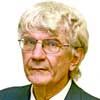Today is the 174th anniversary of the death of independence hero José de San Martín (1778-1850), a date always a public holiday in Argentina when not falling on a weekend. Strange that the country of which he was a founding father should prefer to celebrate his disillusioned death in self-imposed exile over 11,000 kilometres distant in Boulogne-sur-Mer and not the more upbeat occasion of his birth here on home soil. Not that such dates are anything but random – thus San Martín was born on the same day as George Harrison and Néstor Kirchner while united in death with Frederick the Great, Rudolf Hess and Pearl Bailey, among others, but can he be compared with any of them? – and not that there is any lack of current issues (which this space prefers to leave to the other columnists) but since this edition is published on the exact day of the anniversary once every six years, let us stay with the “Saint of the Sword.”
An image from which the Liberator sorely needs liberating – San Martín has become so frozen in marble that his humanity escapes our grasp. A heroic image created by Bartolomé Mitre’s 1887 book Historia de San Martín y de la emancipación sudamericana, which was far more nation-building mythology than serious historical work. The first question might be just how Argentine was a national hero who spent merely 12 of his 72 years in his homeland? The country was not even called the Republic of Argentina in his lifetime (not until 1860) – the “patria grande” was the continental dream of the man who also liberated Chile and Peru. A swarthy man whose many nicknames included “El Indio,” “El Mulato,” “El Paraguayo” (from his Corrientes birth) and “El Cholo” seems an unlikely hero for South America’s most Eurocentric country.
If San Martín was not so Argentine, even less was he a porteño, spending less than two years of his life in this city. While Argentine history has increasingly revolved around this metropolis since it became the Federal Capital in 1880 (with Greater Buenos Aires the axis of Peronism), it never reached 50,000 inhabitants during the Liberator’s sojourn there. If his native Corrientes looked beyond their province, it was not to the capital but to the vision of a riverside state linking up Paraguay and Uruguay along with the provinces of Santa Fe and Entre Ríos (which today would be a country of over 17 million inhabitants, not far behind Chile). But his place in this part of the world was neither his birthplace nor an intrigue-ridden capital but the mountain air of Mendoza, the launching-pad for the Army of the Andes which would free Chile and Peru from Spanish rule.
Beyond the issue of just how Argentine San Martín was, there is the speculation that he was a British agent rather than a Latin American liberator – a fascinating question for an English-speaking newspaper. Speculation explored in Rodolfo Terragno’s book Maitland & San Martín. Although never in South America, Sir Thomas Maitland, a colonial governor in Ceylon (today Sri Lanka) and Malta, was an armchair strategist who devised a plan for the conquest of Spanish America around the 1800 turn of the century when Spain was still a French ally against Britain. The Maitland Plan argued that Spanish America could not be conquered from the Caribbean or the River Plate as too distant from its Lima core – the hardest way up the Andes was actually the easiest with Mendoza explicitly recommended as a starting-point. San Martín was introduced to this plan a decade later while in London via the Logia Lautaro masonic lodge, following it to the letter by crossing the Andes to free Chile before moving up to liberate Peru with the crucial aid of Lord Cochrane’s British naval squadron – with the significant difference that by then Spain was a British ally against the Napoleonic invasion of the Iberian Peninsula. Why should Britain do so much damage to an ally by backing South American liberation? Various reasons, including finding an outlet for half a million soldiers when war in Europe ended, but hard to ignore sheer commercial greed for an emerging market (starting with gun-running for the independence wars).
If San Martín had been converted into a marble statue of all the patriotic virtues by the end of the 19th century, it might have been otherwise in this day and age without secrets or mysteries – not least right now with Alberto Fernández falling into deeper disrepute by the minute. It has become fashionable to apply anachronistic criteria to the distant past – thus in the recently concluded Paris Olympics, Baron Pierre de Coubertin, the founder of the modern Games in 1896, was widely reviled for not including women when they could not even vote worldwide outside New Zealand, South Australia and Wyoming. By the same absurd token San Martín’s marriage to 14-year-old Remedios de Escalada might lead to his being maliciously branded as a statutory rapist or even a paedophile in social network gossip. Far from a perfect marriage with both having their affairs (including an interracial relationship between Remedios and Bernardo de Monteagudo) but San Martín was no Alberto Fernández.
No Alberto Fernández – it is time to stop reducing San Martín to simple humanity and recognise the greatness of the man who freed half a continent. That epic has led to his military prowess being hailed but his organisational genius deserves more recognition – a recent La Nación newspaper article comparing in detail Olympic Village catering with the logistics of the Army of the Andes found that even operating in those extreme altitudes, San Martín offered a more nutritious and varied diet. In conclusion, as much human as superhuman.


















Comments